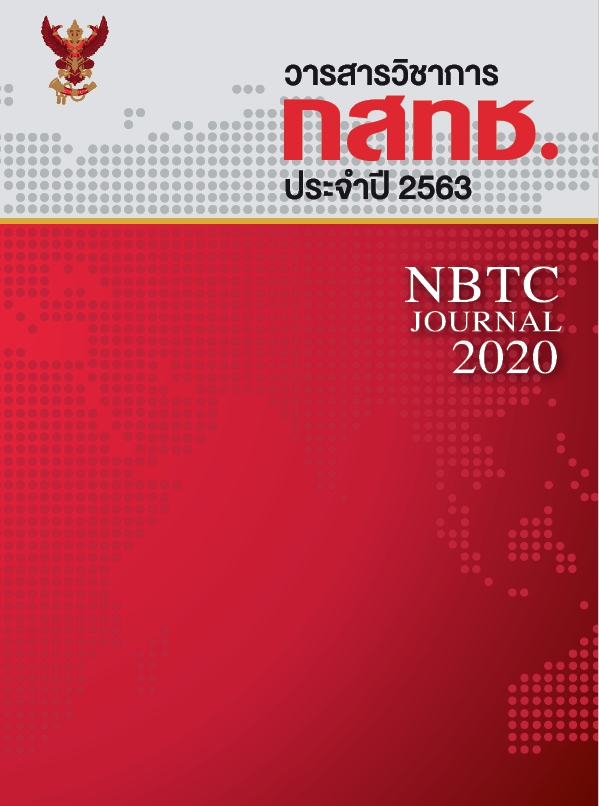Survey the Attitude and Demand of People with Hearing Disabilities towards Television Programs of NBTC
Keywords:
hearing-impaired people, attitude toward TV-program, accessibility serviceAbstract
This research aimed to reach three primary objectives. (1) to realize the opinions and the needs of hearing-impaired adolescents, who have possessed the communication problem, on a series of TV-program under the supervision of National Broadcasting and Telecommunications Commission (NBTC). (2) to initiate the policy recommendations, based upon the empirical findings, that can be implemented so as to improve TV-programs' content and format to fit with participants' need. (3) to facilitate NBCT stimulating the willingness to pay attention to the social-related accountability of TV-program producers, especially the hearing-impaired people. This research used a mixed methods approach. Data were collected through a quantitative-oriented survey of 2,023 and qualitative-oriented interview of 39 hearing-impaired participants. In the first stage, a series of quantitative analysis was conducted, comprising descriptive statistics and the Structural Equation Modeling (SEM). Moreover, thirty-nine respondents were carefully selected to participate in a qualitative interview session. Subsequently, content analysis, data classification, and cause-effects analysis were executed, respectively. Results can be summarized that the attitude toward TV-program under the supervision of NBTC were in moderate level. Accessibility service, media brand equity and credibility were found to have an impact on the attitude of hearing-impaired people. Based on the research findings, the recommended policy related to the service of sign language has been proposed.
References
กระทรวงพัฒนาสังคมและความมั่นคงของมนุษย์. (2561). จำนวนคนพิการในประเทศไทย. ค้นเมื่อ 20 กันยายน 2561, จาก https://www.egov.go.th/th/government-agency/46/.
กนิษฐา รัตนสินธุ์. (2560). สมรรถนะล่ามภาษามือไทยที่แปลในรายการข่าวโทรทัศน์. สารนิพนธ์มหาบัณฑิต, สาขาสื่อสารมวลชน, มหาวิทยาลัยรามคำแหง.
ประกาศคณะกรรมการกิจการกระจายเสียง กิจการโทรทัศน์ และกิจการโทรคมนาคมแห่งชาติ เรื่องการส่งเสริมและคุ้มครองสิทธิของคนพิการให้เข้าถึงหรือรับรู้และใช้ประโยชน์จากรายการของกิจการโทรทัศน์ พ.ศ. 2559. (2559, 5 กุมภาพันธ์). ราชกิจจานุเบกษา.
เล่ม 133 ตอนพิเศษ 35 ง.
ประกาศคณะกรรมการกิจการกระจายเสียง กิจการโทรทัศน์ และกิจการโทรคมนาคมแห่งชาติ เรื่องแนวทางการจัดทำล่ามภาษามือ คำบรรยายแทนเสียง และเสียงบรรยายภาพ พ.ศ. 2560. (2560, 27 ธันวาคม). ราชกิจจานุเบกษา. เล่ม 134 ตอนพิเศษ 322 ง.
ประกาศคณะกรรมการกิจการกระจายเสียง กิจการโทรทัศน์ และกิจการโทรคมนาคมแห่งชาติ เรื่องแนวทางการจัดทำล่ามภาษามือ คำบรรยายแทนเสียง และเสียงบรรยายภาพ เรื่องหลักเกณฑ์และวิธีการปฏิบัติงานของผู้ประกอบกิจการกระจายเสียงและกิจการโทรทัศน์ในกรณีเกิดภัยพิบัติหรือเหตุฉุกเฉิน พ.ศ. 2551. (2551, 1 ตุลาคม). เล่ม 129 ตอนพิเศษ 159 ง.
As' ad, H. A. R., & Alhadid, A. Y. (2014). The impact of social media marketing on brand equity: An empirical study on mobile service providers in Jordan. Review of Integrative Business and Economics Research, 3(1), 315.
ASEAN Community. (2018). ASEAN Enabling Masterplan 2025: Mainstreaming the Rights of Persons with Disabilities. Retrieved from https://asean.org/storage/2018/11/ASEAN-Enabling-Masterplan-2025-Mainstreaming-the-Rights-of-Persons-with-Disabilities.pdf. (29-3-2019).
Cacioppo, J. T., & Berntson, G. G. (1994). Relationship between attitudes and evaluative space: A critical review, with emphasis on the separability of positive and negative substrates. Psychological bulletin, 115(3), 401.
Calvo-Porral, C., Martínez-Fernández, V. A., & Juanatey-Boga, O. (2014). Mass communication media credibility: an approach from the Credible Brand Model. Intercom: Revista Brasileira de Ciências da Comunicação, 37(2),
-49.
Delgado-Ballester, E., & Fernandez Sabiote, E. (2015). Brand experimental value versus brand functional value: which matters more for the brand?. European Journal of Marketing, 49(11/12), 1857-1879.
Ellis, K., & Kent, M. (2015). Accessible television: The new frontier in disability media studies brings together industry innovation, government legislation and online activism. First Monday, 20(9), 419-431.
Federal Communications Commission. (2018). Closed Captioning on Television. retrieved October 2, 2019, from: https://www.fcc.gov/consumers/guides/closed-captioning-television.
Hwang, J., & Lee, K. W. (2018). The antecedents and consequences of golf tournament spectators’ memorable brand experiences. Journal of Destination Marketing & Management, 9, 1-11.
Kimpakorn, N., & Tocquer, G. (2010). Service brand equity and employee brand commitment. Journal of Services Marketing, 24(5), 378-388.
Ladhari, R., & Michaud, M. (2015). eWOM effects on hotel booking intentions, attitudes, trust, and website perceptions. International Journal of Hospitality Management, 46, 36-45.
Priester, J. R., & Petty, R. E. (1996). The gradual threshold model of ambivalence: relating the positive and negative bases of attitudes to subjective ambivalence. Journal of personality and social psychology, 71(3), 431.
Purnomo, S. H., & Lee, Y. H. (2010). Why is understanding customer attitude toward 4Ps marketing mix important? The case of the livestock input industry in Indonesia. Journal of Development and Agricultural Economics, 2(4), 107-114.
Salinas, E. M., & Pérez, J. M. P. (2009). Modeling the brand extensions' influence on brand image. Journal of Business Research, 62(1), 50-60.
The Hong Kong Society for the Deaf. (2014). Press Conference on Supporting the Hearing Impaired Tertiary Students. Retrieved October 2, 2019, from http://www.deaf.org.hk/en/res_res.php.
Yamashita, T., Hahn, S. J., Kinney, J. M., & Poon, L. W. (2018). Impact of life stories on college students’ positive and negative attitudes toward older adults. Gerontology & geriatrics education, 39(3), 326-340.
Downloads
Published
How to Cite
Issue
Section
License
The Office of the NBTC holds the copyright of articles appearing in the journal. The Office of the NBTC allows the public or individuals to distribute, copy, or republish the work under a Creative Commons license (CC), with attribution (BY), No Derivatives (ND) and NonCommercial (NC); unless written permission is received from the Office of the NBTC.
Text, tables, and figures that appear in articles accepted for publication in this journal are personal opinion and responsibility of the author, and not binding on the NBTC and the Office of the NBTC. In case of errors, each author is solely responsible for their own article, and not concerning the NBTC and the NBTC Office in any way.



